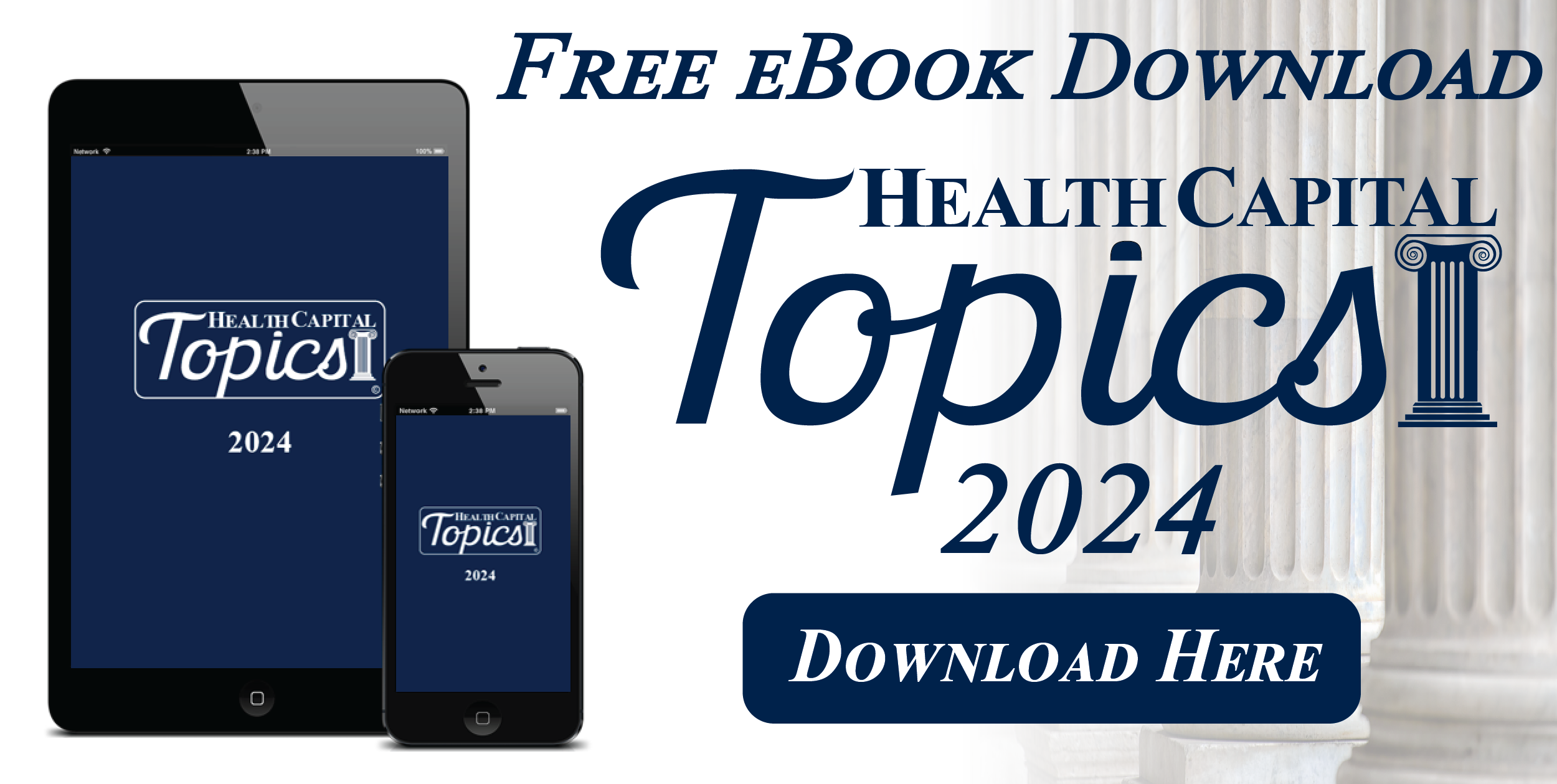During the first 90 days of the Republican Party’s government trifecta (controlling the White House, Senate, and House of Representatives), both the Trump Administration and Congress have laid the groundwork for seismic change to the U.S. healthcare industry. In an attempt to track the latest actions of the federal government’s legislative and executive branches affecting the healthcare industry since the first installment in our February issue,1 this Health Capital Topics article summarizes recent events in Washington and the impact of these changes on providers and patients.
HHS Facing $40 Billion in Cuts
A recently-leaked Office of Management and Budget (OMB) preliminary budget document outlined the Trump Administration’s proposal to cut the Department of Health & Human Services’ (HHS’s) 2026 discretionary budget by one third.2 HHS’s $40 billion budget reduction would largely come from:
Eliminating several HHS rural health programs under the Health Resources and Services Administration (HRSA);
3
Cutting the budget for the Centers for Disease Control and Prevention (CDC) by approximately 44%, in part by eliminating the agency’s global health center and disease prevention programs;
4
Cutting the budget for the National Institutes of Health by over 40%, in part by reducing the agency’s 27 research institutes and centers to eight;
5 and
Capping indirect payments to universities to 15%, although this recently-enacted cut has been halted by the courts.
6
The HHS budget reduction would also be partly accomplished by reorganizing the agency through firings, reductions in force (RIFs), office eliminations, and consolidating multiple programs and departments into the Administration for a Healthy America (AHA).7
Additionally, proposed budget cuts to the Centers for Medicare & Medicaid Services (CMS) assume “a decline in Federal Exchange enrollment due to the expiration of the enhanced premium tax credits.”8 In other words, the enhanced Affordable Care Act (ACA) subsidies, which are provided to lower-income individuals to purchase health insurance on the ACA insurance exchanges, and have been in place since 2021, would be allowed to sunset at the end of 2025.9 While this may be an upfront cost savings, a recent Commonwealth Fund report found that letting the enhanced ACA premium subsidies expire would cost states $34 billion in gross domestic product reductions and $2 billion in tax revenue.10 Revenues of hospitals and healthcare providers would be especially affected by these cuts, as an estimated 4 million Americans will lose their insurance and premiums will increase by a projected 4.3%.11
Healthcare Payments Frozen
The U.S. Department of Government Efficiency (DOGE) has started a new effort called “Defend the Spend” to restrain billions of dollars in federal healthcare grants.12 Federal officials are now required “to manually review and approve previously routine payments…[leaving] thousands of payments backed up, including funding for doctors’ and nurses’ salaries at federal health centers for the poor.”13 While the effort is intended to force both the government and grantees to justify the spending and enhance transparency, agencies are reporting “inconsistent instructions on how to proceed” and “immediate backlogs in processing payments.”14 Federal health centers, which rely on regular drawdowns in promised grant money to pay for clinicians’ salaries and supplies, are already experiencing the negative impact of these backlogs and could ultimately close if funding continues to be withheld.15
Tariff Implications on Healthcare Organizations
The Trump Administration’s tariffs war has ebbed and flowed during the first 90 days, with the president instituting substantial tariffs on most U.S. trading partners, then announcing on April 9, 2025 that the administration would pause most reciprocal tariffs for 90 days.16 Because medical supplies and devices tend to come from overseas, hospitals and other healthcare organizations are significantly concerned about rising costs and the uncertain availability of supplies.17 A recent Black Book Market Research study of 200 industry professionals found that 80% of respondents expect hospitals’ and health systems’ costs to increase at least 15% in the next several months due to import cost increases.18 America’s Essential Hospitals and other healthcare groups and organizations sent a letter to the U.S. trade representative asserting that the tariffs:
“ultimately place[] further financial pressure on providers, hospitals, and health systems, particularly those located in rural and medically underserved areas… increased costs on medical and dental supplies could impede [organizations’] ability to improve treatment outcomes, foster innovation, and meet the growing needs of pediatric and adult populations. This could result in longer wait times, reduced access to necessary treatments, and greater financial strain on health care systems that are already under pressure.19
While tariffs do not currently apply to pharmaceuticals, President Trump has stated that a “major” tariff on pharmaceuticals will be implemented “very shortly.”20 In 2024, the U.S. imported nearly $213 billion worth of pharmaceuticals,21 meaning that any pharmaceutical tariff will likely have a far-reaching impact on the healthcare industry.
Conclusion
Healthcare organizations are experiencing significant unpredictability and uncertainty as a result of these abrupt and capricious federal policy changes. With organizations already operating on thin margins, changes that result in higher expenses and/or decreased revenue could be a death knell for hospitals and other providers, with the ultimate consequence of significantly reducing patients’ access to healthcare services.
Health Capital Consultants will continue to closely monitor these developments and will provide in-depth analysis and updates in forthcoming issues of Health Capital Topics.
“Fast & Furious: Healthcare Policy Edition” Health Capital Topics, Vol. 18, Issue 2 (February 2025), https://www.healthcapital.com/hcc/newsletter/02_25/HTML/GOV/convert_govt-hc-updates-topics.php (Accessed 4/17/25).
“Internal budget document reveals extent of Trump’s proposed health cuts” By Lena H. Sun, et al., The Washington Post, April 16, 2025, https://www.washingtonpost.com/health/2025/04/16/hhs-budget-cut-trump/ (Accessed 4/21/25).
“Internal Trump administration document reveals massive budget cut proposal for federal health agencies” By Sarah Owermohle and Meg Tirrell, CNN, April 16, 2025, https://www.cnn.com/2025/04/16/politics/trump-rfk-jr-budget-cut-health/index.html (Accessed 4/17/25).
Sun, et al., The Washington Post, April 16, 2025.
“Leaked HHS budget signals $40B in cuts, assumes ACA subsidies expire” By Noah Tong, Fierce Healthcare, April 17, 2025, https://www.fiercehealthcare.com/regulatory/hhs-budget-slashed-40-billion-first-look-hhs-reorganization-leaked-document (Accessed 4/17/25).
“Five Things to Know about the Renewal of Extra Affordable Care Act Subsidies in the Inflation Reduction Act” By Cynthia Cox, Kaiser Family Foundation, August 11, 2022, https://www.kff.org/policy-watch/five-things-to-know-about-renewal-of-extra-affordable-care-act-subsidies-in-inflation-reduction-act/#:~:text=Subsidies%20in%20the%E2%80%A6-,Five%20Things%20to%20Know%20about%20the%20Renewal%20of%20Extra%20Affordable,in%20the%20Inflation%20Reduction%20Act&text=As%20part%20of%20the%20Inflation,previously%20priced%20out%20of%20coverage. (Accessed 4/21/25).
“The Cost of Eliminating the Enhanced Premium Tax Credits: Economic, Employment, and Tax Consequences” By Leighton Ku, et al., The Commonwealth Fund, Issue Briefs, March 3, 2025, https://www.commonwealthfund.org/publications/issue-briefs/2025/mar/cost-eliminating-enhanced-premium-tax-credits (Accessed 4/17/25).
Tong, Fierce Healthcare, April 17, 2025.
“DOGE begins to freeze health-care payments for extra review” By Dan Diamond, et al., The Washington Post, April 17, 2025, https://www.washingtonpost.com/politics/2025/04/17/doge-trump-grants-hhs-nih-backlog/?utm_campaign=wp_post_most&utm_medium=email&utm_source=newsletter&carta-url=https%3A%2F%2Fs2.washingtonpost.com%2Fcar-ln-tr%2F4228cad%2F680278c809671829d6cd43ef%2F596adcaeade4e24119a8edff%2F26%2F52%2F680278c809671829d6cd43ef (Accessed 4/21/25).
“Tariff turmoil: Hospitals, device makers welcome pause, but fear long-term pain” By Susanna Vogel and Susan Kelly, Healthcare Dive, April 10, 2025, https://www.healthcaredive.com/news/tariff-turmoil-hospitals-device-makers/745093/#:~:text=%E2%80%9CThis%20ultimately%20places%20further%20financial,continue%20caring%20for%20their%20communities.%E2%80%9D (Accessed 4/21/25).
Letter to The Honorable Jameison Greer, U.S. Trade Representative, AdvaMed, et al., dated April 1, 2025, available at: https://www.advamed.org/wp-content/uploads/2025/04/Health-Group-Tariff-Letter-to-USTR-4-1-25.pdf (Accessed 4/21/25).
“Pharmaceutical stocks rise as Trump pauses tariffs but not for China” By Annika Kim Constantino, CNBC, April 9, 2025, https://www.cnbc.com/2025/04/09/trump-pharmaceutical-tariffs-announcement.html (Accessed 4/21/25).





